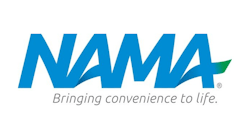National Automatic Merchandising Association Meets With New York City Officials To Modify Vending Standards On City Property
Representatives from the National Automatic Merchandising Association (NAMA) and the New York State Automatic Vending Association (NYSAVA) recently met with Andrew Goodman, deputy commissioner of the New York City Department of Health (NYCDOH) and other department officials, and have established an important working relationship, Dan Mathews, NCE5 CCS, NAMA executive vice president and chief operating officer announced.
The meeting, to discuss New York City Mayor Michael Bloomberg’s executive order implementing standards for food/snack and beverage vending on city property, resulted in an agreement by the NYCDOH to review metrics and trends related to healthier vend choices in New York City.
“Both NAMA and NYSAVA are recognized resources NYCDOH officials may consult with before undertaking regulations that impact vending,” Mathews said in a prepared statement. “This is great news for our industry, because we need to have a seat at the table when these critical issues are being debated.”
The standards, which went into effect in December, 2011, were promoted by NYCDOH fliers that contained language suggesting that locations “decide whether vending machines are necessary and consider removing machines if possible.”
“While we understand the intentions of New York City legislators, removing vending machines is flat-out wrong,” Mathews said. “Hundreds of local vending-related jobs and an entire industry would be at risk. We wanted to ensure that decision makers hear our voice to prevent government involvement in an issue of this magnitude.”
“Now, we look forward to working with NYCDOH decision-makers and other officials within Mayor Bloomberg’s Administration to share important industry data,” he continued.
According to Mathews, the department also agreed to work with NAMA on communications sent out to the private sector regarding vending to ensure that the messaging is consistent, and that private industries are aware that the standards are voluntary. The review will also ensure that inflammatory language/suggestions such as “removing vending from your facilities” are no longer used.
In addition to Deputy Commissioner Goodman and his key staff, attending the meeting on behalf of NAMA were Sheree Edwards, regional legislative director, and Pam Gilbert, senior manager of government affairs. The two were joined by NYSAVA President Brian Gill and John Murn and Tom Murn, principals of Answer Vending, Inc., based in Farmingdale, N.Y.
When asked about the specifics of the meeting, Edwards explained that she shared the respective associations’ member concerns regarding the NYCDOH’s actions.
“We want to avoid regulations that would have negative impact on vending at any level. I also mentioned that pressuring private businesses to conform to the standards – or suggesting that vending be eliminated altogether– is not the way to get consumers to make better choices. I reminded them that first, vending is a retail channel linked to an economy of small businesses, jobs, and valuable revenue sources; and second, with a market as large as New York City, the NYCDOH has a responsibility to consider the unintended consequences of their regulations.”
“We also made sure the department of health officials understood how proactive NAMA has been in the health and wellness arena, with both our Balanced for Life and Fit Pick programs. While the Department officials were generally aware of Fit Pick, we were pleased to provide them with supplemental information and to answer specific questions,” said Gilbert.
John Murn and Tom Murn led a discussion regarding the New York City vending industry’s response to the need for healthier products through innovative technology and consumer demand.
“They did a wonderful job in describing how their company (and similar large vending operators in the city) utilizes new technology to track healthy product sales and respond to customer requests. Brian Gill talked about challenges smaller operators face in this regard, but that programs like Fit Pick allow them to still provide healthy items to their customer bases,” said Edwards.
According to Edwards, Deputy Commissioner Goodman was very interested in the metrics on how healthier items are selling in both small and large operations, as well as the effectiveness of using price differentials for healthier vending items. He reportedly also would like to know if NAMA could make the data available to the NYCDOH for consideration.
The team also discussed other options, including modifying the city's RFPs for vending contracts, to perhaps make them based on the percentage of healthier items carried or sold rather than on strict dollar amounts, as well as changing the commissions and maximizing the use of price differentials for healthier items.
“We especially want to thank New York State Automatic Vending Association President Brian Gill, and members John Murn and Tom Murn, who are going to work with their fellow operators to provide the department of health with a sampling of their customer and product data. Our members consistently say that working to protect them from legislative threats is one of the most valuable benefits NAMA delivers, and we’re glad to now have a voice in New York City to ensure we continue to protect our members’ interests,” said Mathews.





